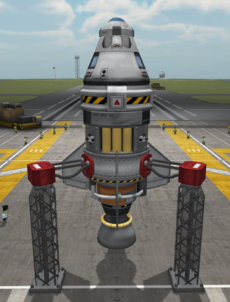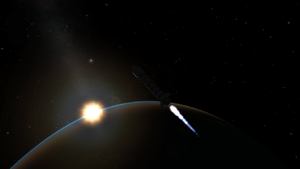Difference between revisions of "Rocket"
Mnethercutt (talk | contribs) (removed stub notice) |
(Added a photo of a rocket circularizing.) |
||
| (5 intermediate revisions by 4 users not shown) | |||
| Line 1: | Line 1: | ||
[[File:Kerbal x launchpad.png|thumb|upright|The [[Kerbal X]] can achieve an orbit around Kerbin]] | [[File:Kerbal x launchpad.png|thumb|upright|The [[Kerbal X]] can achieve an orbit around Kerbin]] | ||
[[File:Kerbal 2.png|thumb|upright|The [[Kerbal 2]] is only capable of a sub-orbital flight]] | [[File:Kerbal 2.png|thumb|upright|The [[Kerbal 2]] is only capable of a sub-orbital flight]] | ||
| − | A '''rocket''' is a vertically launched [[craft]]. Usually it uses [[rocket engine]]s to propel it forward and doesn't | + | [[File:Screenshot46.png|thumbnail|left|A rocket carrying payload finalizing its circularization burn.]] |
| + | A '''rocket''' is a vertically launched [[craft]]. Usually it uses [[rocket engine]]s to propel it forward and doesn't use the lift of [[wing]]s or [[winglet]]s. It only uses [[control surface]]s to help steering in an [[atmosphere]]. Another option for atmospheric control is the [[Vernor Engine]], which can provide good attitude control at the cost of fuel. The main purpose of a rocket is to reach space and an [[orbit]], or at least a sub-orbital flight. | ||
The [[payload]] is a passive part of the rocket - usually mounted on the top. The starting stages of the rocket lifting the rest to the orbit commonly called [[launch vehicle]]. The radially attached and [[decoupler|separable]] auxiliary rockets help the main rocket to gain altitude and speed are the boosters. | The [[payload]] is a passive part of the rocket - usually mounted on the top. The starting stages of the rocket lifting the rest to the orbit commonly called [[launch vehicle]]. The radially attached and [[decoupler|separable]] auxiliary rockets help the main rocket to gain altitude and speed are the boosters. | ||
| Line 11: | Line 12: | ||
Rockets are built in the [[Vehicle Assembly Building]] and then launched on the [[launch pad]]. | Rockets are built in the [[Vehicle Assembly Building]] and then launched on the [[launch pad]]. | ||
| − | == | + | == Launch == |
The usual flight profile starts on the launchpad on [[Kerbin]]. Prior to liftoff, any jet engines need to be started to run at full throttle on liftoff. When the jet engines are running at full power, the liftoff can be initiated by activating the rocket engines and releasing any [[TT18-A Launch Stability Enhancer]]s. | The usual flight profile starts on the launchpad on [[Kerbin]]. Prior to liftoff, any jet engines need to be started to run at full throttle on liftoff. When the jet engines are running at full power, the liftoff can be initiated by activating the rocket engines and releasing any [[TT18-A Launch Stability Enhancer]]s. | ||
| − | The planned orbital [[orbit#Inclination|inclination]] for the intended orbit – [[Orbit#Types of orbits|prograde, polar…]] – is crucial for the start to minimize fuel costs. For example, equatorial retrograde orbit, where the | + | The planned orbital [[orbit#Inclination|inclination]] for the intended orbit – [[Orbit#Types of orbits|prograde, polar…]] – is crucial for the start to minimize fuel costs. For example, equatorial retrograde orbit, where the craft rotates in the other direction than the [[celestial body]] beneath it, means inclination of 180°. While the Kerbin rotates counter-clockwise, seen from the North pole, it means western direction (270°), and the prograde orbit aligned with rotation of the body means eastern direction (90°). As general, the equatorial prograde direction (exactly 90°) is the most profitable, because in this case the sidereal rotation velocity is added to the orbital speed - means fuel saving - but in case of retrograde orbit the rotation works against the rocket. The northern-southern polar orbit (inclination of 0° and 180°) are preferable for scanning the whole area of the celestial body as it's rotating beneath it. |
At first, rocket then starts the vertical climbing to rise and accelerate continues so until reaching the proper altitude for the pitchover maneuver (at Kerbin it is about 2 km). At this point a [[gravity turn]] is initiated by tilting (of ~2° in this case) in the desired direction. From this moment the tilt slowly and continuously increases, reaches the value of 15-20° at 10 km, and value of ~45-50° at 20 km, and increases on and on at higher altitudes. Ideally, from the pitchover maneuver there is no need of interfering - the [[drag]] of the [[winglet]]s on the bottom of rocket the turns the rocket during the gravity turn. With the gravity turn the craft starts to pick up horizontal velocity, which is crucial for a stable [[orbit]]. The engines continuing to accelerate the vessel to raise the apoapsis and periapsis out of the atmosphere. | At first, rocket then starts the vertical climbing to rise and accelerate continues so until reaching the proper altitude for the pitchover maneuver (at Kerbin it is about 2 km). At this point a [[gravity turn]] is initiated by tilting (of ~2° in this case) in the desired direction. From this moment the tilt slowly and continuously increases, reaches the value of 15-20° at 10 km, and value of ~45-50° at 20 km, and increases on and on at higher altitudes. Ideally, from the pitchover maneuver there is no need of interfering - the [[drag]] of the [[winglet]]s on the bottom of rocket the turns the rocket during the gravity turn. With the gravity turn the craft starts to pick up horizontal velocity, which is crucial for a stable [[orbit]]. The engines continuing to accelerate the vessel to raise the apoapsis and periapsis out of the atmosphere. | ||
| − | The altitude and the angle of the pitchover maneuver depends on the properties of the celestial body. In low-G worlds without atmosphere the pitchover maneuver can be started immediately after the lift-off, and the angle is far more (several 10 degrees!) | + | The altitude and the angle of the pitchover maneuver depends on the properties of the celestial body. In low-G worlds without atmosphere the pitchover maneuver can be started immediately after the lift-off, and the angle is far more (several 10 degrees!). But there is opposite case ([[Eve]]), when the vertical climb continues for higher altitudes. The properties of the rocket, like [[TWR]], drag, staging also affects the shape of the ideal ascending trajectory. |
| − | As soon as the apoapsis and periapsis are outside the atmosphere (about 69 km), the | + | As soon as the apoapsis and periapsis are outside the atmosphere (about 69 km), the craft's orbit will not decrease, and has reached a parking orbit. From this orbit it is possible to initiate [[basic maneuvers|orbital maneuvers]] like the Hohmann transfer to change the orbital shape. |
[[Category:Craft]] | [[Category:Craft]] | ||
Latest revision as of 15:16, 14 August 2017


A rocket is a vertically launched craft. Usually it uses rocket engines to propel it forward and doesn't use the lift of wings or winglets. It only uses control surfaces to help steering in an atmosphere. Another option for atmospheric control is the Vernor Engine, which can provide good attitude control at the cost of fuel. The main purpose of a rocket is to reach space and an orbit, or at least a sub-orbital flight.
The payload is a passive part of the rocket - usually mounted on the top. The starting stages of the rocket lifting the rest to the orbit commonly called launch vehicle. The radially attached and separable auxiliary rockets help the main rocket to gain altitude and speed are the boosters.
With various stages, rockets can dump dry mass and become more efficient, while a spaceplane usually doesn't have stages. As they don't use lift to maintain altitude, the rocket engines need to counteract gravity. To determine if the rocket can lift off, the thrust-to-weight ratio can be determined. If the ratio is above one, the thrust generated by the engines is higher than the gravitational force and thus the rocket will lift off. Because the engines drain fuel, the craft gets lighter so the ratio also increases with the flight.
Because rockets don't need lift surface, they work in every environment and don't need an atmosphere. On the other hand, rocket engines with sufficient thrust are far more inefficient than jet engines with similar thrust.
Rockets are built in the Vehicle Assembly Building and then launched on the launch pad.
Launch
The usual flight profile starts on the launchpad on Kerbin. Prior to liftoff, any jet engines need to be started to run at full throttle on liftoff. When the jet engines are running at full power, the liftoff can be initiated by activating the rocket engines and releasing any TT18-A Launch Stability Enhancers.
The planned orbital inclination for the intended orbit – prograde, polar… – is crucial for the start to minimize fuel costs. For example, equatorial retrograde orbit, where the craft rotates in the other direction than the celestial body beneath it, means inclination of 180°. While the Kerbin rotates counter-clockwise, seen from the North pole, it means western direction (270°), and the prograde orbit aligned with rotation of the body means eastern direction (90°). As general, the equatorial prograde direction (exactly 90°) is the most profitable, because in this case the sidereal rotation velocity is added to the orbital speed - means fuel saving - but in case of retrograde orbit the rotation works against the rocket. The northern-southern polar orbit (inclination of 0° and 180°) are preferable for scanning the whole area of the celestial body as it's rotating beneath it.
At first, rocket then starts the vertical climbing to rise and accelerate continues so until reaching the proper altitude for the pitchover maneuver (at Kerbin it is about 2 km). At this point a gravity turn is initiated by tilting (of ~2° in this case) in the desired direction. From this moment the tilt slowly and continuously increases, reaches the value of 15-20° at 10 km, and value of ~45-50° at 20 km, and increases on and on at higher altitudes. Ideally, from the pitchover maneuver there is no need of interfering - the drag of the winglets on the bottom of rocket the turns the rocket during the gravity turn. With the gravity turn the craft starts to pick up horizontal velocity, which is crucial for a stable orbit. The engines continuing to accelerate the vessel to raise the apoapsis and periapsis out of the atmosphere.
The altitude and the angle of the pitchover maneuver depends on the properties of the celestial body. In low-G worlds without atmosphere the pitchover maneuver can be started immediately after the lift-off, and the angle is far more (several 10 degrees!). But there is opposite case (Eve), when the vertical climb continues for higher altitudes. The properties of the rocket, like TWR, drag, staging also affects the shape of the ideal ascending trajectory.
As soon as the apoapsis and periapsis are outside the atmosphere (about 69 km), the craft's orbit will not decrease, and has reached a parking orbit. From this orbit it is possible to initiate orbital maneuvers like the Hohmann transfer to change the orbital shape.
